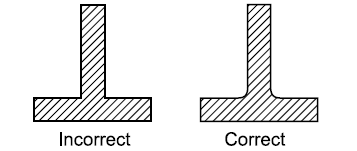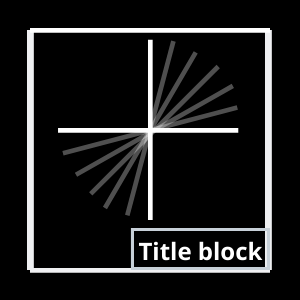Engineering design
W5-3
Professor: Oscar Alonso Rosete Beas

Previous session
-
Introduction to drawing standards
-
Introducing the title block
-
Portfolio drafts(3,4)
Agenda
- Drawing terminology
- Bisecting lines
- Portfolio draft (5)
Laboratory sessions
CAT´S LAB A

First activity

Second activity

Third activity
Portfolio draft (4)

Portfolio draft (5)
1
2
3
4
5
6
7
8
title block
Fillet
A fillet is a small radius formed between the inside angle of two surfaces. Fillets are often used to help reduce stress and strengthen an inside corner. They are common on the inside corners of castings and forgings to strengthen corners and reduce stress during molding. Fillets are also used to help a casting or forging release a mold or die. Fillets are arcs given as radius dimensions. The fillet size depends on the function of the part and the manufacturing process used to make the fillet.


Round
A round is a small-radius outside corner formed between two surfaces. Rounds are used to refine sharp corners. In situations in which a sharp corner must be relieved and a round is not required, a slight corner relief can be used, referred to as a break corner. The note BREAK CORNER can be used on the drawing. Another option is to provide a note that specifies REMOVE ALL BURRS AND SHARP EDGES.
Burrs are machining fragments that are often left on a part after machining.

Fillet



Sketching a one-view drawing with fillets

Sketching a one-view drawing with fillets
1. Lightly sketch the centerlines for the overall width and height of the part. Estimate overall proportions by eye, or if you know the dimensions, use a measuring scale to sketch accurately sized views. Space the enclosing rectangle equally from the margins of the sheet.


Sketching a one-view drawing with fillets
2. Block in all details lightly, keeping the drawing proportions in mind.


Sketching a one-view drawing with fillets

3. Locate the centers of circles and arcs. Block in where they will fit using rectangles. Then, sketch all arcs and circles lightly.

Sketching a one-view drawing with fillets

4. Darken your final lines.
Add annotations to the drawing using neat lettering.
Fill in the title block or title strip. Note the scale for the sketch if applicable. If not, letter NONE in the Scale area of the title block.

Portfolio 9

One-View drawing of a shim
Frame of 1 cm

Portfolio 10
David A mansen engineering drawing

Portfolio 11
David A mansen engineering drawing
Drawing Standards

Drawing Standards
Note that drawing sheet size is given as height × width. Most standard sheets use what is called a “landscape” orientation.
The use of the basic sheet size, 8.5 × 11.0 or 210 mm × 297 mm, and its multiples permits filing folded prints in
standard files with or without correspondence. These sizes can
be cut from standard rolls of media.
Sketching an arc


tangent of two circle

tutorials solidworks


Technical Drawing W5-3
By oscaralonso11
Technical Drawing W5-3
- 396





